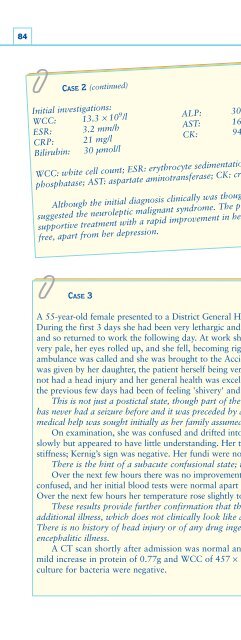You also want an ePaper? Increase the reach of your titles
YUMPU automatically turns print PDFs into web optimized ePapers that Google loves.
84CASE 2 (continued)Initial investigations:WCC: 13.3 × 10 9 /l ALP: 306 IU/lESR: 3.2 mm/h AST: 167 IU/lCRP: 21 mg/l CK: 9499 IU/lBilirubin: 30 µmol/lWCC: white cell count; ESR: erythrocyte sedimentation rate; CRP: C-reactive protein; ALP: alkalinephosphatase; AST: aspartate aminotransferase; CK: creatine kinase.Although the initial diagnosis clinically was thought to be a septicaemic illness, the very high CK levelsuggested the neuroleptic malignant syndrome. The prochlorperazine was stopped and she was givensupportive treatment with a rapid improvement in her clinical state from admission, to being symptomfree,apart from her depression.CASE 3A 55-year-old female presented to a District General Hospital with a week’s history of a flu-like illness.During the first 3 days she had been very lethargic and rather drowsy, but brightened up on the fourth dayand so returned to work the following day. At work she had had a seizure; eyewitnesses said she had becomevery pale, her eyes rolled up, and she fell, becoming rigid. The seizure lasted about 1 minute and anambulance was called and she was brought to the Accident and Emergency Department. The informationwas given by her daughter, the patient herself being very drowsy. The patient had no history of epilepsy, hadnot had a head injury and her general health was excellent. She had not vomited and her complaints duringthe previous few days had been of feeling 'shivery' and aching all over, including a headache.This is not just a postictal state, though part of the confusion may be related to the seizure. This patienthas never had a seizure before and it was preceded by a febrile illness with an alteration in her alertness. Nomedical help was sought initially as her family assumed she had the flu until she had the seizure.On examination, she was confused and drifted into sleep unless stimulated. She answered questionsslowly but appeared to have little understanding. Her temperature was 37.7°C (99.9°F). There was no neckstiffness; Kernig’s sign was negative. Her fundi were normal and there were no focal neurological signs.There is the hint of a subacute confusional state; there is no clinical evidence of meningitis.Over the next few hours there was no improvement in the patient’s clinical state, she remained drowsy andconfused, and her initial blood tests were normal apart from a gamma-glutamyl transferase (GT) of 87 IU/l.Over the next few hours her temperature rose slightly to 38°C (100.4°F) and later that day to 39°C (102.2°F).These results provide further confirmation that this is not a postictal confusion, but there is anadditional illness, which does not clinically look like acute meningitis, although this has to be considered.There is no history of head injury or of any drug ingestion. The course and tempo of the illness suggest anencephalitic illness.A CT scan shortly after admission was normal and lumbar puncture was carried out. The CSF had amild increase in protein of 0.77g and WCC of 457 × 10 9 /l, 99% of these were lymphocytes. Staining andculture for bacteria were negative.(Continued on page 85)
















